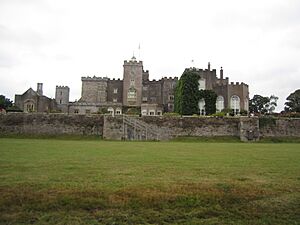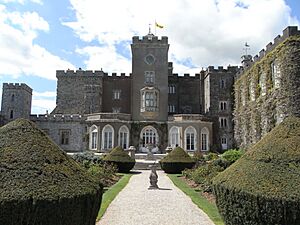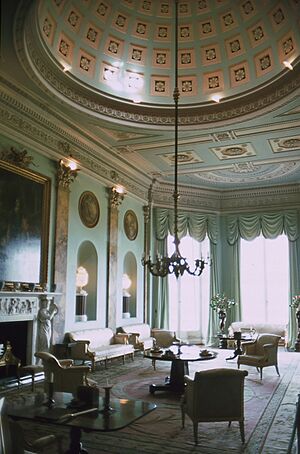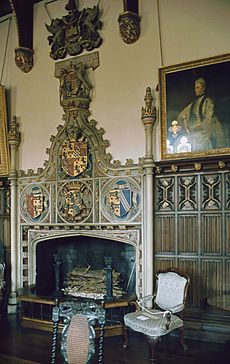Powderham Castle facts for kids
Quick facts for kids Powderham Castle |
|
|---|---|

Gatehouse
|
|
| General information | |
| Architectural style | Gothic |
| Location | Exminster, Devon, United Kingdom |
| Construction started | 14th century (medieval core) |
| Renovated | 18th century |
| Owner | Courtenay family |
Powderham Castle is a grand old house, built like a fortress, located in Exminster, Devon. It's about 6 miles (10 km) south of Exeter. The main entrance is near the village of Kenton. This castle is a very important historical building, known as a Grade I listed building. Its beautiful park and gardens are also specially protected, listed as Grade II*.
The castle sits on flat land next to the River Exe estuary, where the River Kenn joins it. Across the River Exe is the small village of Lympstone. The first part of the castle was built after 1390. Over the years, especially in the 1700s and 1800s, it was made much bigger and changed a lot. Powderham Castle is the home of the Courtenay family, who are the Earls of Devon.
Contents
What's in a Name?
The name Powderham comes from an old Dutch word, "polder." This means "the village of the reclaimed marsh-land." So, Powderham was built on land that was once a wet, marshy area.
A Look Back in Time
The main part of Powderham Castle was built by Sir Philip Courtenay, who passed away in 1406. He was a son of Hugh Courtenay, the 2nd Earl of Devon. For a long time, the main Earls of Devon lived at Tiverton Castle. But the Courtenay family at Powderham became very important local leaders in Devon. They served as judges, sheriffs, and members of parliament.
After 1556, the main line of the Courtenay family at Tiverton ended. This meant the Courtenays of Powderham became the rightful Earls of Devon. They officially became Earls in 1831.
The building was originally a strong manor house, not a true castle with a big keep or a moat. The name "castle" probably became popular in the 1600s. It did have a defensive wall on the east side, but these parts were removed in the 1700s to create better views of the River Exe. Many of the castle-like features you see on the main entrance (west side) were added in the 1800s. For example, the gatehouse was built between 1845 and 1847.
Battles and Changes
During the Wars of the Roses, the Courtenay Earls of Devon were enemies with the Bonville family. However, Sir William Courtenay of Powderham married a Bonville, which made Powderham a stronghold for the Bonville side against the Earls of Devon. In 1455, the Earl of Devon, Thomas de Courtenay, led an army of 1,000 men. He took control of Exeter and then surrounded Powderham Castle for two months. Later, the Earl defeated Lord Bonville in a battle near Exeter.
The English Civil War
During the English Civil War, Powderham Castle was defended by 300 Royalist soldiers. In December 1645, Parliamentarian soldiers tried to capture it but failed at first. However, they succeeded on January 25, 1646. The castle was badly damaged during this attack. It remained partly open to the weather until the early 1700s when Sir William Courtenay repaired it.
Inside Powderham Castle
The house is built around its original 14th and 15th-century core. This old part included a withdrawing room, a great hall, and kitchens. Today, these areas are the ante-room, Staircase Hall, Marble Hall, and Victorian kitchen.
The Marble Hall
The Marble Hall has a striking black and white marble floor and was finished in 1755. It used to be the lower part of the medieval great hall. In the early 1700s, the great hall was divided into the Staircase Hall and the Marble Hall. The Marble Hall was originally very tall, but a ceiling was added in the 1700s to create bedrooms above.
This room was once the "screens passage," which was an entrance area in medieval great halls. While the old wooden screen is gone, you can still see three medieval stone doorways that led to the kitchens. There's also a higher doorway that once led to a wooden gallery where musicians would play.
Today, the Marble Hall is a sitting room with an 18th-century fireplace. You can see a 14-foot (4.3 m) tall longcase clock from around 1745 and a large 17th-century tapestry above the fireplace. There's also a carved wooden fireplace decoration from 1553 with the Courtenay family crest.
Other Interesting Features
The castle mixes old medieval parts with beautiful 18th-century decorations. Upstairs, there's a narwhal tusk. Some people used to believe these were unicorn horns and could detect poison!
The Dining Hall Fireplace
William Courtenay, the 11th Earl of Devon, added a special fireplace to the Dining Hall around 1860. He did this to remember his grandfather, Reginald Courtenay, who was the Bishop of Exeter, and his parents. The Dining Hall itself was built by his father between 1847 and 1859. The 11th Earl finished decorating it in 1860, adding wooden panels with many family crests. This fireplace is a copy of an old medieval one found in the Bishop's Palace in Exeter.
Powderham Castle Today
Since 1745, many changes have been made to the castle's appearance, especially from the outside. For example, the second library was added, and some low rooms were changed to have bow windows. The old gatehouse tower, which might have blocked the view, was removed. The area around the River Kenn has also been landscaped.
Powderham Castle has been a Grade I listed building since 1952, meaning it's recognized as a very important historical structure. Parts of the castle, like the staircase, hall, music room, and master bedroom, were used as filming locations for the 1993 movie The Remains of the Day. It was also used for the comedy film Churchill: The Hollywood Years.
In 2008, the Earl of Devon sold a 14th-century book called the Courtenay Compendium, which was found at Powderham. In 2009, the Earl also auctioned off some items from the castle at Sotheby's in London. This sale raised over £1 million, which was used to pay off debts. The Earl later handed control of the estate to his son, Charles, who is now the 19th Earl of Devon. The castle's license to host weddings and civil partnerships has been reinstated, so it's a popular venue for special events.
In 2017, Mary Berry visited the castle and filmed a TV show there as part of her series Mary Berry's Country House Secrets. In 2018, Powderham Castle opened new rooms and areas that were once private family spaces. They now offer two new guided tours, which was the first time the tours had been changed since the 1950s.
Fun Events at the Castle
Powderham Castle is also a popular place for concerts and events!
- On August 2, 2004, the Irish boy band Westlife held a concert there.
- The rock band Status Quo played concerts at Powderham Castle in 2003 and again in 2009.
- In May 2016, Powderham Castle hosted BBC Radio 1's Big Weekend, a huge music festival with artists like Ellie Goulding, Coldplay, The 1975, and Craig David.
- Since then, other famous artists like Noel Gallagher's High Flying Birds, Little Mix, Bryan Adams, and Tom Jones have performed there.
- In 2019, Powderham Castle started its own Food Festival, which brings together food and drink stalls from across the West Country.
- During the COVID-19 pandemic, the castle began hosting a special Christmas light trail and experience called "Christmas at the Castle."







